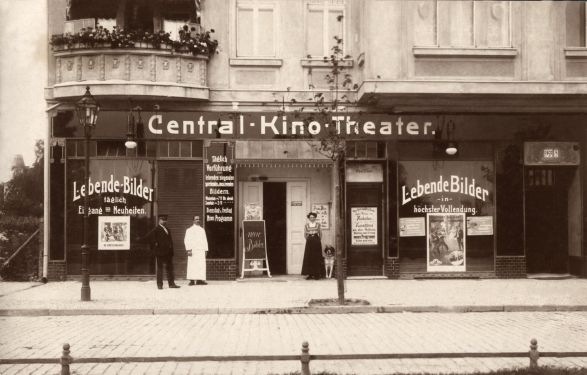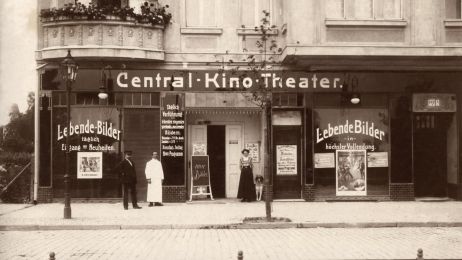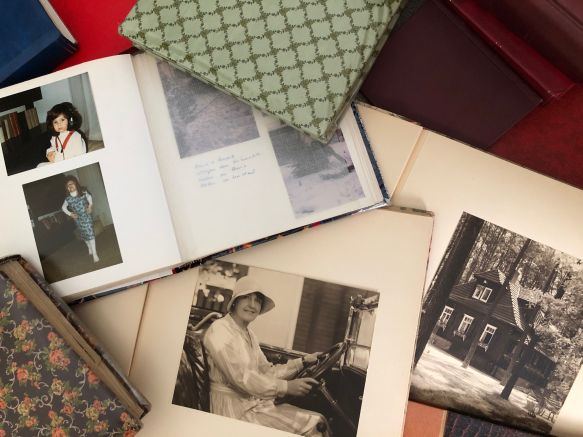
Photographs on Movie Theater History in Berlin
General information
-
Contact
To the Photo ArchiveFelix Endruweit
fotoarchiv [at] deutsche-kinemathek.de (fotoarchiv[at]deutsche-kinemathek[dot]de)
“Of course, Berlin is terrific. You’ll think you’re sitting in a movie theater.”
With these words the city transformed into a cinema in Erich Kästner’s novel ‘Emil und die Detektive’ ‒ when it got dark on Nollendorfplatz and movie theaters everywhere opened their doors. Cinema reveals worlds full of adventure and attractions in movie theaters that are sites of encounters, entertainment and places for reflection. They play a part in our personal memories, social lives and the urban architecture. Berlin’s cityscape was (and continues to be) shaped by its movie theaters. Many of them, both great and small, have disappeared, been torn down or redesigned. Very few have survived across the decades.
Our archives contain numerous photographs of Berlin movie theaters, which we are presenting together for the first time. The seven chronological photo galleries available here allow you to browse through our collection on the history of these cinemas and immerse yourself in historical views of Berlin.
Gallery
-
 1905–1918: The German Empire’s First Cinemas21 images
1905–1918: The German Empire’s First Cinemas21 images -
 1919–1932: The Weimar Republic18 images
1919–1932: The Weimar Republic18 images -
 1933–1945: National Socialism5 images
1933–1945: National Socialism5 images -
 1946–1949: The Postwar Period7 images
1946–1949: The Postwar Period7 images -
 1949–1960: After the Founding of the Two German States23 images
1949–1960: After the Founding of the Two German States23 images -
 1961–1989: Divided Berlin after the Construction of the Wall16 images
1961–1989: Divided Berlin after the Construction of the Wall16 images -
 From 1990: Reunified Germany31 images
From 1990: Reunified Germany31 images
The History of Cinemas in Berlin
The History of Cinemas in Berlin
Movie theaters have been an integral part of urban and cultural life in Berlin since the start of the 20th century. From the very beginning there were differing contextual and architectural concepts, which evolved over the course of decades. They ranged from a variety theater panopticum to small, local movie theaters and colossal film palaces, and from communal to commercial cinemas. Their programs covered a wide spectrum oscillating between information and entertainment – each influenced by their own time and consequently also falling in line with contemporaneous ideological or propagandistic categories. Movie theaters quickly faced competition ‒ from radio as of the 1920s, later from television, and now from digital film providers. Time and again, there has been talk of the death of the cinemas. However, constant change is inherent to Berlin’s cinema culture, whose closures, breaks, new openings and reopenings continue to characterize the city.
1903–1918: The German Empire’s First Cinemas
The first public film screening took place in Berlin at the end of 1895 at the Central Hotel’s Varieté Wintergarten, where Max and Emil Skladanowsky showed their “moving pictures.” The first permanent venue dedicated to the screening of films – Otto Pritzkow’s Abnormitäten- und Biograph-Theater on Münzstraße – is presumed to have been built four years later in the Spandauer Vorstadt (now Berlin-Mitte). A rapid increase of cinema openings occurred in the following period, especially in largely proletarian locations; there were only 16 in 1905, but by 1907 there were 139. Local cinemas, known as “Ladenkinos”, were often combined with a beer bar. The typical “Kintopp” entertained its guests as a blend of movie theater and entertainment bar and thrived on the boisterous participation of its audiences.
Technical innovations and resourceful tinkerers continued to make new projection methods possible. Experiments were undertaken with sound media. For instance, long before talkies, a synchronized gramophone and projector at the Apollo-Theater (a variety theater) allowed opera scenes to be shown as a sound film at the beginning of the 20th century. By 1913 an open-air cinema, the Garten-Kinematographen-Theater, had opened in Berlin-Charlottenburg. Two years later the imperial capital boasted between 300 and 400 movie theaters – “for Berliners, cinema is a basic necessity.” (Der Kinematograph, no. 267, Feb. 7, 1912; here in translation)
1919–1932: The Weimar Republic
Cinema architecture had its heydey – analogous to the development of the metropolitan area – following World War I. Some cinemas showed their versatile programs in several screenings throughout the day. Film palaces sometimes played to more than a thousand viewers. The Ufa-Palast am Zoo offered 1740 seats (increased to 2165 seats after its reconstruction in 1925), the Phoebus Palast in Berlin-Kreuzberg had just under 1400 and the gigantic Titania-Palast in Berlin-Steglitz almost 2000 seats. The movie theaters were often a mix of prestigious and functional buildings, both ceremonial and intending to offer distractions. The U.T. (Union-Theater) on Kurfürstendamm, for example, was built in a Wilhelmine neoclassical style with a temple-like gabled front.
Fritz Wilms was among the most important cinema architects of this period. In the mid-1920s he conceived the redesign of the Colosseum, a grand cinema on Schönhauser Allee. He also played a key role in the realization of the Mercedes-Palast, Turm-Palast and Luna-Palast, the Alhambra and the Piccadilly. One of the most magnificent cinema buildings in the city stems from Hans Poelzig: In 1929 he designed the Babylon movie theater on Bülow-Platz (now Rosa-Luxemburg-Straße). Enhanced by its original cinema organ, it can still be visited today. The Lichtburg also opened in 1929 ‒ it was the cultural center of the newly constructed Gartenstadt Atlantic development in Berlin-Gesundbrunnen, designed by Rudolf Fränkel. Otto Werner was responsible for erecting the Filmtheater am Friedrichshain in a neoclassical style and Erich Mendelsohn built the Kino Universum ‒ now used as the Schaubühne theater ‒ in the middle of a building ensemble.
1933–1945: National Socialism
The impact of Adolf Hitler’s appointment as chancellor of Germany on January 30, 1933 was quickly felt in the film production and movie theater branches. It resulted in discrimination, expropriation and persecution targeting Jewish and politically objectionable film and cinema makers. More than 1500 actors fled in the following period into exile. Jewish movie theater owners were barred from carrying out their occupation. Political conformity was enforced throughout the entire film industry, resulting in German Jews being banned from their professions at all levels. The remaining movie theater owners, who had often appropriated formerly Jewish property, swore their allegiance to Adolf Hitler.
Outside the production of explicitly National Socialist propaganda films, diverse film industry regulations also prevented the emergence of “subversive” films or those violating National Socialist ideology. The viewing public, however, didn’t always accept being limited to a single interpretation and occasionally enjoyed ambivalence in entertainment films. Meanwhile movie theaters continued showing foreign films, including American productions until the United States entered the war. Some theaters were converted into cinemas. Major movie theaters continued to be concentrated in Berlin-Schöneberg and Tiergarten, among them the Astor, which was erected on Kurfürstendamm in 1934 with almost three hundred seats. The Kurbel, Berlin’s first movie theater to exclusively screen sound films, opened in 1935 on Giesebrechtstraße in Charlottenburg.
Allied air raids on Berlin during World War II, especially as of 1943, led to the destruction of numerous cinemas, including the Gloria Palast on Kurfürstendamm, which burned down after being struck by a bomb in 1943. Nonetheless, a large number of Berlin movie theaters continued screening films until August 1944. In the following months many theaters had to close, with only a few remaining in operation until 1945, for example the Tauentzienpalast, a venue favored for premieres.
1946–1949: The Postwar Period
During the postwar years the movie schedule provided distraction and dispersion – in all sectors of the occupied city. The first movie theaters began their operations again in the ruins of a totally demolished Berlin. In the sectors controlled by the Western Allies, films and newsreels aimed at reeducation were increasingly utilized in movie theaters. Among them was Hanus Burger’s documentary film about the concentration camps, ‘Die Todesmühlen’ (‘Death Mills’, co-production of Germany and Western Allies / USA, 1945), which was shown in 51 Berlin movie theaters in 1946. In the Soviet-occupied part of city, films were also shown for the purpose of reeducating the German population, for example the documentary ‘Sud narodov’ (distributed in English as ‘The Nuremberg Trials’, USSR, 1947). With most of the prestigious movie theaters located in the Western part of Berlin, attempts were made to establish Babylon as the Eastern venue for premieres – a hope, however, that remained unfulfilled. In the Western sectors of Berlin, the Bahnhofslichtspiele (or Bali for short) opened in Zehlendorf in 1946. The Kurbel had begun showing films again as early as May 1945, followed by KiKi – Kino im Kindl – in 1948. Shortly thereafter the Cinéma Paris was established in the Maison de France on Kurfürstendamm.
1949–1960: After the Founding of the Two German States
Numerous movie theaters reopened or were newly constructed on both sides of Berlin as of 1949. In West Berlin the first Berlin International Film Festival (Berlinale) took place in 1951, at the initiative of United States film officer Oscar Martay, with the Zoo Palast becoming its main venue in 1957. The Delphi am Zoo reopened its doors in 1949, and the partially destroyed Alhambra in Charlottenburg was put back into operation as the Bonbonniere. In Schöneberg the Sylvia Filmbühne opened in 1950, showing its program of films in their original language versions. The Colosseum in Prenzlauer Berg offered its viewing public films screened in Totalvision (the East German version of Cinemascope) when it reopened in 1957, and went on to become the first venue for premieres of films produced by the Deutsche Film AG (DEFA).
The “border cinemas” were a special feature of Berlin at the time. They were located very close to the inner-city, East-West border in the Western sector and operated from 1950 to 1961. East Berlin residents could buy movie tickets at an exchange rate of one East German Mark (DDM) for one West German Mark (DM) and were thus able to watch West German films inexpensively. These movie theaters included the Lido at the Schlesisches Tor subway station and the City, located directly at Checkpoint Charlie (both in the American sector), Bali in Reinickendorf in the French sector, and the World Cinema in Alt-Moabit at Lehrter Stadtbahnhof in the British sector.
1961–1989: Divided Berlin after the Construction of the Wall
With the student revolts of the 1960s, West Berlin became characterized by critical political movements, including one advocating community movie venues. This led to the founding of several collective movie theaters. The Arsenal on Welserstraße, founded in 1970 by the Freunde der Deutschen Kinemathek e.V. (now Arsenal – Institut für Film und Videokunst), was among the first municipally backed cinemas in the Federal Republic of Germany. In 1981 the Eiszeit cinema (whose name stemmed from the lack of heating in the squatted house in Schöneberg) opened as an alternative to those movie theaters that seemed to be run on purely commercial grounds. In the same period the Regenbogenkino and Sputnik movie theater collectives were founded in Kreuzberg.
Movie theaters in East Berlin were largely nationalized and subsumed into the “Bezirksfilmdirektion” (district film directorate) in 1963. The old middle-class movie theater buildings were often in poor condition, making it impossible to keep using them. Others had to close, like the Tilsiter Lichtspiele in Friedrichshain in 1961.
Television marked a turning point in movie theater culture. The number of moviegoers declined similarly in the Federal Republic of Germany and the German Democratic Republic as of the late 1950s. One consequence was that large-capacity movie theaters were divided up into multiplex theaters for the first time. Nevertheless, large movie theaters continued to open, including the Kosmos in 1962 and the International on Karl-Marx-Allee in 1963, both of which were architecturally impressive, solitary structures built in a modern style.
Since 1990: Reunified Germany
The Berlin International Film Festival (Berlinale) began using screening venues in both the eastern and western parts of the city in 1990, drawing diverse cinemas in Berlin into a mutual cultural context after years of separation. In the following year the debut of the Kino im Brotfabrik in Berlin-Weissensee marked the opening of the first East Berlin arthouse cinema. The founding activities by collectives continued in the post-Reunification period. This included an association reopening the Tilsiter Lichtspiele after a 30-year involuntary intermission in the eastern half of Berlin and the opening of the Filmrauschpalast Moabit e.V. in a house squatted by artists. The small fsk (the initials for “Flugzeugsesselkino”, or airplane seat cinema) moved from Wiener Straße to Segitzdamm in the western half of the city in 1994, retaining several of its trademark airplane seats. For years the façade lettering of the Turm-Palast in Moabit remained a reminiscence of movie theaters’ past glory, although the venue had closed in the mid-1970s and, like many other abandoned movie theaters, been converted into a department store.
In the mid- to late 1990s, large cinema complexes with an average of ten screens were built in Berlin’s various districts. But even these large commercial enterprises weren’t immune to difficulties. The showcase CineStar movie theater in the Sony Center on Potsdamer Platz had to close in December 2019 after 20 years in operation.
2020: To Be Continued …
“Like no other city, Berlin lives and loves its cinemas and its versatile film program that is unparalleled in Europe,” read a promotional text for some forty Berlin local and arthouse movie theaters in June 2020. They had joined forces in the face of Covid-19 closures of their screens and started what was likely a one-of-a-kind crowdfunding campaign to preserve the diversity of Berlin’s movie theater landscape. The participants included Berlin’s oldest movie theater still in operation – Moviemento ‒ founded in 1907. Also involved were movie theaters newly opened in the 2010s, some initiated with crowdfunding, venues that once again combined a restaurant area with moviegoing, such as Il Kino and Wolf in Berlin-Neukölln. After a forced interruption of their programs, Berlin’s movie theaters were allowed to reopen their doors and screens on July 2, 2020. Following four months of limited operation, local movie theaters have had to close their doors again on November 2, 2020, due to new health and safety regulations intended to stop the spread of Covid-19. We hope that our exceptional cinema landscape can withstand this crisis.
Your Movie Theater Photographs in Our Archives

Your Movie Theater Photographs in Our Archives
Photographs of movie theaters are part of our collection. The inventory has grown over the decades yet never been systematically collected, leaving it incomplete as a result. After 1960 the number of movie theater photographs decreased, with only a few individual images taken over the last 20 years. East Germany and East Berlin are less well represented than West Germany. Help us close these gaps and keep the memory of our movie theaters alive. Share your photographs of Berlin movie theaters with us and everyone else. They are guaranteed a long life in our photo archive.
Credits
Credits
Project direction: Peter Mänz
Project idea: Julia Riedel
Concept and image selection: Julia Pattis, Julia Riedel
Texts: Jennifer Borrmann
Professional archiving support: Julia Riedel
Content-related advice: : Matthias Struch, Jörg Becker
Translation into English: Wendy Wallis
Digitization: Siegmar Brüggenthies
Special thanks
We would like to express our gratitude to Volker Noth, who entrusted us with his archive and whose many photographs of Berlin's cinemas sparked the idea for this online presentation. We would like to thank the passionately operated websites on cinema history for being a great source of inspiration and a great source for our research, especially www.alleskinos.com and www.kinokompendium.de.
Copyright
All of the contents and photographs published in the context of the online presentation are protected by copyright and may only be used by third parties with prior written consent.